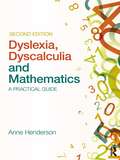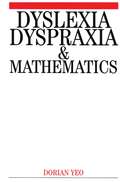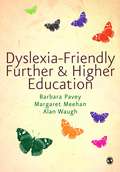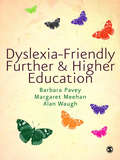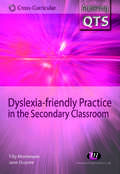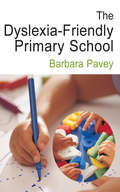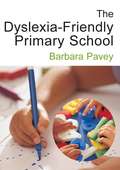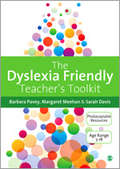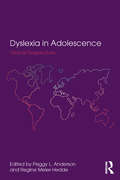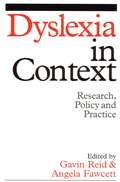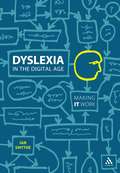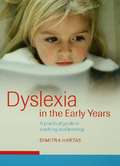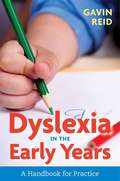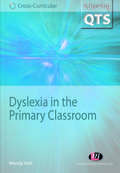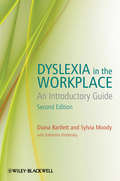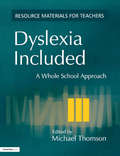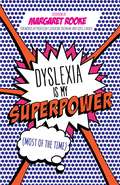- Table View
- List View
Dyslexia, Dyscalculia and Mathematics: A practical guide
by Anne HendersonDyslexia, Dyscalculia and Mathematics will be an essential resource for teachers, classroom assistants, and SENCOs who help dyslexic and dyscalculic children with their understanding of mathematics. Written in an accessible style with helpful illustrations, this practical book reveals helpful ways in which to tackle both simple and complex concepts with students of all ages. This second edition has been updated to include references to using technology that will help children with dyslexia and dyscalculia reinforce their mathematical skills and also contains a number of photocopiable resources that can be used in the classroom. Written by Anne Henderson, who is experienced in teaching language and mathematics to pupils with dyslexia and dyscalculia, this book outlines current thinking in the field and shows how the research methods that have been proven as successful can be used with whole classes of children. This book encourages flexible methods and gives teachers the confidence to discuss alternative solutions with their pupils and help them achieve success. It is an ideal handbook for parent-teacher programmes and is also suitable for in-service training.
Dyslexia, Dyspraxia and Mathematics
by Dorian YeoWritten by a teacher with many years' experience of teaching mathematics to primary school dyslexic and dyspraxic children with a wide range of abilities, this book is designed to be a practical teaching guide. It offers detailed guidance and specific teaching suggestions to all specialist teachers, support teachers, classroom teachers and parents who either directly teach mathematics to dyslexic and dyspraxic children or who support the mathematics teaching programmes of dyslexic or dyspraxic children. Although the book has grown out of teaching experience it is also informed by widely acknowledged contemporary and international research, which explores the cognitive aspects of learning mathematics and tries to understand why it is that some children fail to learn mathematics. Many of the teaching principles described in the text have specific and quite far-reaching implications. The theoretical arguments should therefore also be of interest to special needs co-ordinators, heads of maths departments, head teachers or other professionals who are responsible for designing or modifying the maths learning programmes of children with special learning and maths difficulties. In more general terms, the book hopes to contribute to the broad discussion of the cognitive features and educational needs of dyslexic and dyspraxic children.
Dyslexia-Friendly Further and Higher Education
by Margaret Meehan Alan Waugh Barbara PaveyWritten by authors with extensive experience of working with students with dyslexia, this book provides clear guidance and practical strategies for dyslexia-friendly practice for those working with young people aged 14 to 19 and adults in education or work-based training. Looking at how dyslexia impacts on learning, the authors suggest ways to improve the learning environment and explain how to help students develop the basic skills that will help them to make the transition from study to employment. Building on the latest research and understanding of dyslexia, they also consider overlapping characteristics, emotional and social issues and funding. The book includes: - visual chapter summaries - case studies drawn from practice - ideas for dyslexia-friendly written work, and lab and bench work - international perspectives - a selection of resources - model lesson plans and useful checklists This is essential reading not only for those studying dyslexia-focused programmes at Master's level, but also for mainstream practitioners wishing to improve their dyslexia knowledge and practice, and an ideal resource for professionals working in a school, college, university or adult setting, or delivering training and consultancy in this field. Barbara Pavey is a Senior Lecturer in Education at York St John University. Margaret Meehan is the Dyslexia Coordinator at Swansea University. Alan Waugh is Programme Area Manager for Additional Support at City College, Coventry.
Dyslexia-Friendly Further and Higher Education
by Alan Waugh Barbara Pavey Margaret MeehanWritten by authors with extensive experience of working with students with dyslexia, this book provides clear guidance and practical strategies for dyslexia-friendly practice for those working with young people aged 14 to 19 and adults in education or work-based training. Looking at how dyslexia impacts on learning, the authors suggest ways to improve the learning environment and explain how to help students develop the basic skills that will help them to make the transition from study to employment. Building on the latest research and understanding of dyslexia, they also consider overlapping characteristics, emotional and social issues and funding. The book includes: - visual chapter summaries - case studies drawn from practice - ideas for dyslexia-friendly written work, and lab and bench work - international perspectives - a selection of resources - model lesson plans and useful checklists This is essential reading not only for those studying dyslexia-focused programmes at Master's level, but also for mainstream practitioners wishing to improve their dyslexia knowledge and practice, and an ideal resource for professionals working in a school, college, university or adult setting, or delivering training and consultancy in this field. Barbara Pavey is a Senior Lecturer in Education at York St John University. Margaret Meehan is the Dyslexia Coordinator at Swansea University. Alan Waugh is Programme Area Manager for Additional Support at City College, Coventry.
Dyslexia-friendly Practice in the Secondary Classroom
by Dr Tilly Mortimore Jane DupreeThe first guide of its kind written specifically for trainee and newly qualified teachers, this standards-based text explores the needs of dyslexic learners in mainstream secondary schools. In light of the current dyslexia-friendly schools initiative, it looks at organisational-level support for dyslexic children, together with pragmatic strategies which teachers can use to support children's cross-curricular learning. Further, it includes case studies and practical tasks to build readers' confidence in supporting Specific Learning Difficulties, as well as a range of coping strategies and practical advice, based upon the authors' experience of working with dyslexic learners in different contexts over many years.
Dyslexia-friendly practice in the secondary classroom
by Tilly Mortimore Jane DupreeThe first guide of its kind written specifically for trainee and newly qualified teachers, this standards-based text explores the needs of dyslexic learners in mainstream secondary schools. In light of the current dyslexia-friendly schools initiative, it looks at organisational-level support for dyslexic children, together with pragmatic strategies which teachers can use to support children's cross-curricular learning. Further, it includes case studies and practical tasks to build readers' confidence in supporting Specific Learning Difficulties, as well as a range of coping strategies and practical advice, based upon the authors' experience of working with dyslexic learners in different contexts over many years.
The Dyslexia-Friendly Primary School: A Practical Guide for Teachers
by Barbara PaveyIs your school dyslexia-friendly? Beginning with a look at understanding dyslexia, this book shows you how to involve the whole school in order to achieve a dyslexia-friendly environment. You will be able to: - use an audit tool to discover how dyslexia-friendly your school is - look at examples of successful dyslexia-friendly initiatives - find information on funding and resources. This book offers a step-by-step guide to creating a dyslexia-friendly classroom and whole-school environment. Headteachers, deputy headteachers, class teachers, SENCOs, student teachers and literacy co-ordinators wanting to make their school more dyslexia-friendly will find this practical book extremely useful. Barbara Pavey worked as a teacher and SEN specialist for many years and is now Lecturer in Learning Disabilities at The University of Manchester.
The Dyslexia-Friendly Primary School: A Practical Guide for Teachers (PDF)
by Barbara PaveyIs your school dyslexia-friendly? Beginning with a look at understanding dyslexia, this book shows you how to involve the whole school in order to achieve a dyslexia-friendly environment. You will be able to: - use an audit tool to discover how dyslexia-friendly your school is - look at examples of successful dyslexia-friendly initiatives - find information on funding and resources. This book offers a step-by-step guide to creating a dyslexia-friendly classroom and whole-school environment. Headteachers, deputy headteachers, class teachers, SENCOs, student teachers and literacy co-ordinators wanting to make their school more dyslexia-friendly will find this practical book extremely useful. Barbara Pavey worked as a teacher and SEN specialist for many years and is now Lecturer in Learning Disabilities at The University of Manchester.
The Dyslexia-Friendly Teacher's Toolkit: Strategies for Teaching Students 3-18 (1st edition) (PDF)
by Barbara Pavey Margaret Meehan Sarah Davis'This book is a really practical, hands-on guide packed woth a wealth of advice on strategies and "things to try" reflecting the authors' extensive experience. If you want to make effective, inclusive dyslexia-friendly classrooms a reality rather than an aspiration, this book is for you'-Dr John P. Rack, Head of Research and Development, Dyslexia Action In this toolkit the authors provide you with the foundations for making your setting and your teaching style dyslexia-friendly. There is a general overview of the principles and practices required, and what the dyslexia-aware teacher needs to bear in mind. Chapters cover: - understanding learners with dyslexia; - dyslexia and phonics; - dyslexia and English as an Additional Language; - dyslexia and mathematics; - dyslexia and science; - dyslexia and creativity. Each chapter includes visual chapter overviews, tried and tested strategies for the classroom and the whole school, using technology to help learners, case studies from practice, children's voices and sources of further information. The book offers you ideas and advice, and will ensure you feel confident you are doing the right things to help overcome barriers to learning. Barbara Pavey is a lecturer in Higher Education, training dyslexia specialists in the North of England. Margaret Meehan is Coordinator of Specialist Tuition at Swansea University Sarah Davis is an Early Years Leading Teacher working in North Yorkshire
The Dyslexia-Friendly Teacher's Toolkit: Strategies for Teaching Students 3-18 (1st edition)
by Barbara Pavey Margaret Meehan Sarah Davis'This book is a really practical, hands-on guide packed woth a wealth of advice on strategies and "things to try" reflecting the authors' extensive experience. If you want to make effective, inclusive dyslexia-friendly classrooms a reality rather than an aspiration, this book is for you'-Dr John P. Rack, Head of Research and Development, Dyslexia Action In this toolkit the authors provide you with the foundations for making your setting and your teaching style dyslexia-friendly. There is a general overview of the principles and practices required, and what the dyslexia-aware teacher needs to bear in mind. Chapters cover: - understanding learners with dyslexia; - dyslexia and phonics; - dyslexia and English as an Additional Language; - dyslexia and mathematics; - dyslexia and science; - dyslexia and creativity. Each chapter includes visual chapter overviews, tried and tested strategies for the classroom and the whole school, using technology to help learners, case studies from practice, children's voices and sources of further information. The book offers you ideas and advice, and will ensure you feel confident you are doing the right things to help overcome barriers to learning. Barbara Pavey is a lecturer in Higher Education, training dyslexia specialists in the North of England. Margaret Meehan is Coordinator of Specialist Tuition at Swansea University Sarah Davis is an Early Years Leading Teacher working in North Yorkshire
The Dyslexia Handbook: Procedures Concerning Dyslexia and Related Disorders
by Texas Education AgencyThe Texas Education Agency (TEA) handbook contains the SBOE-approved procedures concerning dyslexia and related disorders. It provides guidelines for school districts to follow as they identify and provide services for students with dyslexia. Additionally, the handbook provides school districts and parents/guardians with information regarding the state's dyslexia statutes and their relation to these federal laws.
Dyslexia in Adolescence: Global Perspectives
by Peggy L. Anderson Regine Meier-HeddeDyslexia in Adolescence: Global Perspectives presents international case studies on the psychosocial development and academic progress of adolescents with dyslexia to enhance understanding of adjustment factors, outcomes and support. The continuation of a qualitative longitudinal research project that focused on children between ten and twelve years of age, this volume revisits them between ages fourteen and sixteen. Through semi-structured interviews, personal narratives, and other assessments, these case studies relate the trials and tribulations associated with the development of adolescents with dyslexia from around the world and the challenges that parents face in supporting their children.
Dyslexia in Adolescence: Global Perspectives
by Peggy L. Anderson Regine Meier-HeddeDyslexia in Adolescence: Global Perspectives presents international case studies on the psychosocial development and academic progress of adolescents with dyslexia to enhance understanding of adjustment factors, outcomes and support. The continuation of a qualitative longitudinal research project that focused on children between ten and twelve years of age, this volume revisits them between ages fourteen and sixteen. Through semi-structured interviews, personal narratives, and other assessments, these case studies relate the trials and tribulations associated with the development of adolescents with dyslexia from around the world and the challenges that parents face in supporting their children.
Dyslexia in Context: Research, Policy and Practice
by Gavin Reid Angela FawcettThis book highlights the most recent developments in the area of research, policy and practice. All the authors are well known in the field of dyslexia and they will offer significant contributions at the forthcoming BDA conference ' Dyslexia: the dividends from research to policy and practice' to be held at Warwick University in March 2004. In addition to the opening chapter, which provides an overview of developments in dyslexia, there are also chapters on the research associated with neurological factors, the cerebellum, genetics and the links between research and practice. The policy section provides insights into policy developments from Europe, the UK and the United States, as well as polic developments relating to both children and adults. The practice section is comprehensive with chapters on multilingualism, the range of specific learning difficulties, ICT, mathematics, the implications for the classroom from the science of learning and the features of dyslexia friendly schools.
Dyslexia in the Digital Age: Making IT Work
by Ian SmytheDyslexia is a complex condition, and every dyslexic needs a different solution. Technology is not that solution, but a part of the process to minimise the impact of dyslexia on individuals and to assist with the difficulties they face in everyday situations, so that they can demonstrate their potential in school or at work. This book takes the reader back to basics, from understanding the needs of the dyslexic individual to getting the most from available technology. It does this by providing frameworks from theoretical perspectives and following this through to practical implementation, including reviews of the most common types of software. There is plenty of practical advice on how to support dyslexic individuals using technology, including how to get the most out of what is available. It highlights state of the art technology, and suggests what more still needs to be done to make this technology truly enabling for all dyslexics.
Dyslexia in the Digital Age: Making IT Work
by Ian SmytheDyslexia is a complex condition, and every dyslexic needs a different solution. Technology is not that solution, but a part of the process to minimise the impact of dyslexia on individuals and to assist with the difficulties they face in everyday situations, so that they can demonstrate their potential in school or at work. This book takes the reader back to basics, from understanding the needs of the dyslexic individual to getting the most from available technology. It does this by providing frameworks from theoretical perspectives and following this through to practical implementation, including reviews of the most common types of software. There is plenty of practical advice on how to support dyslexic individuals using technology, including how to get the most out of what is available. It highlights state of the art technology, and suggests what more still needs to be done to make this technology truly enabling for all dyslexics.
Dyslexia in the Early Years: A Practical Guide to Teaching and Learning
by Dimitra HartasPacked full of activities, real-life case studies, tasks and suggestions, this informative book will equip teachers with the kind of practical knowledge needed to teach young children with dyslexia effectively. Tackling the subject in a clear and realistic way, the author encourages teachers to think critically in terms of the changing nature of special educational needs, and teaching and learning in early years. She addresses a variety of classroom issues, such as: assessment and identification of dyslexia summarising and commenting on current debates exploring the links between dyslexia, language, and social and emotional development the most effective instructional methods and teaching styles conducive to supporting pupils with dyslexia in early years settings. In addition the book considers the implications of current research for everyday classroom practice, makes recommendations for employing technologies and for accessing web-based information and resources.
Dyslexia in the Early Years: A Practical Guide to Teaching and Learning
by Dimitra HartasPacked full of activities, real-life case studies, tasks and suggestions, this informative book will equip teachers with the kind of practical knowledge needed to teach young children with dyslexia effectively. Tackling the subject in a clear and realistic way, the author encourages teachers to think critically in terms of the changing nature of special educational needs, and teaching and learning in early years. She addresses a variety of classroom issues, such as: assessment and identification of dyslexia summarising and commenting on current debates exploring the links between dyslexia, language, and social and emotional development the most effective instructional methods and teaching styles conducive to supporting pupils with dyslexia in early years settings. In addition the book considers the implications of current research for everyday classroom practice, makes recommendations for employing technologies and for accessing web-based information and resources.
Dyslexia in the Early Years: A Handbook for Practice
by Gavin ReidResearch has shown that early identification and intervention is crucial and can in fact minimise, and may even prevent, the challenges of dyslexia from becoming too detrimental at later stages of education. This book offers both research insights and practical guidance for teachers working in Early Years settings on how to create resource materials that would be suitable for the development of children with dyslexia. Beginning with a contextual note on the key difficulties faced by children at risk of dyslexia, the book takes the reader through the processes of identification and diagnosis, before offering ideas on how to tailor classroom materials for these students. The book's resource materials are designed to target areas such as reading, spelling, numeracy, language skills, social and emotional development, and problem solving skills.
Dyslexia in the Early Years: A Handbook for Practice (PDF)
by Gavin ReidResearch has shown that early identification and intervention is crucial and can in fact minimise, and may even prevent, the challenges of dyslexia from becoming too detrimental at later stages of education. This book offers both research insights and practical guidance for teachers working in Early Years settings on how to create resource materials that would be suitable for the development of children with dyslexia. Beginning with a contextual note on the key difficulties faced by children at risk of dyslexia, the book takes the reader through the processes of identification and diagnosis, before offering ideas on how to tailor classroom materials for these students. The book's resource materials are designed to target areas such as reading, spelling, numeracy, language skills, social and emotional development, and problem solving skills.
Dyslexia in the Primary Classroom
by Wendy HallThis book is an important resource for all primary trainees. It provides an explanation of what dyslexia is and how it affects a child's learning, suggests simple activities which can be used to screen children ready for referral and outlines some easy-to-follow activities addressing different learning styles. It is full of practical suggestions on how to teach reading, spelling and mathematics, develop writing and help with classroom organisation for children displaying difficulties in these areas. The Primary National Strategy is considered throughout and clear links are made to the Professional Standards for the Award of QTS.
Dyslexia in the Workplace: An Introductory Guide
by Diana Bartlett Sylvia Moody Katherine KindersleyThe second edition of Dyslexia in the Workplace is a comprehensive guide to how dyslexic adults in employment can improve their skills, and how their employers and other professionals can help. Offers invaluable insights for overcoming obstacles to success, enhancing workplace efficiency and ensuring that dyslexic employees achieve their full potential Written in an accessible style that is perfect for professionals and dyslexic individuals alike Covers related syndromes such as dyspraxia, attention deficit disorder and visual stress Explores the legal obligations and other issues that are important to workplace managers, especially human resources professionals Provides authoritative guidance on recent case law relating to dyslexia
Dyslexia Included: A Whole School Approach
by Michael ThomsonThis practical book provides teachers with techniques and suggestions to help dyslexic pupils. Written by a team of experienced practitioners who work in a specialist school, it offers clear guidance and tried and tested strategies to help those who need support in this area. The book addresses reading and spelling difficulties and also other aspects of pupils' learning difficulties, including: accessing the curriculum; dyspraxia and motor development problems; learning mathematics; the use of ICT; developing phonological coding; and understanding dyslexics' behaviour. Teachers and teaching assistants working in specialist and mainstream primary and secondary schools should find the book useful. It is also relevant to those doing specialist courses in dyslexia.
Dyslexia Included: A Whole School Approach
by Michael ThomsonThis practical book provides teachers with techniques and suggestions to help dyslexic pupils. Written by a team of experienced practitioners who work in a specialist school, it offers clear guidance and tried and tested strategies to help those who need support in this area. The book addresses reading and spelling difficulties and also other aspects of pupils' learning difficulties, including: accessing the curriculum; dyspraxia and motor development problems; learning mathematics; the use of ICT; developing phonological coding; and understanding dyslexics' behaviour. Teachers and teaching assistants working in specialist and mainstream primary and secondary schools should find the book useful. It is also relevant to those doing specialist courses in dyslexia.
Dyslexia is My Superpower (Most of the Time)
by Margaret RookeIn more than 100 interviews, children and young adults reveal their personal tips and tactics for honing the creative benefits of dyslexia, enabling them to thrive in school and beyond. Strategies include ways to develop confidence and self-belief. The contributors have outlined specific approaches they feel have helped them, and others that haven't. The book contains stunning illustrations by 8-18 year olds with dyslexia.The first-hand accounts are inspiring in the way they normalise dyslexia and reveal the many success stories. There is an additional section for professionals who work in education or special learning environments, with advice given by school students themselves.
